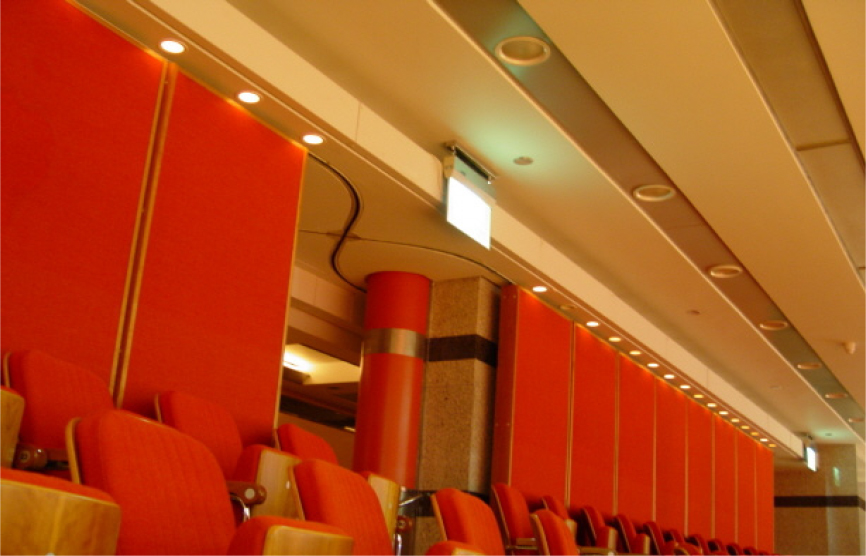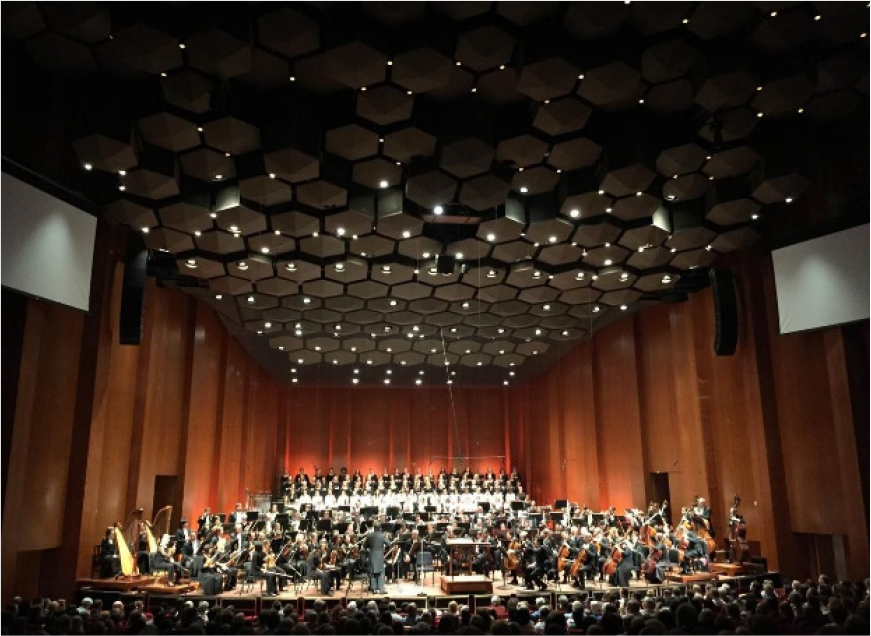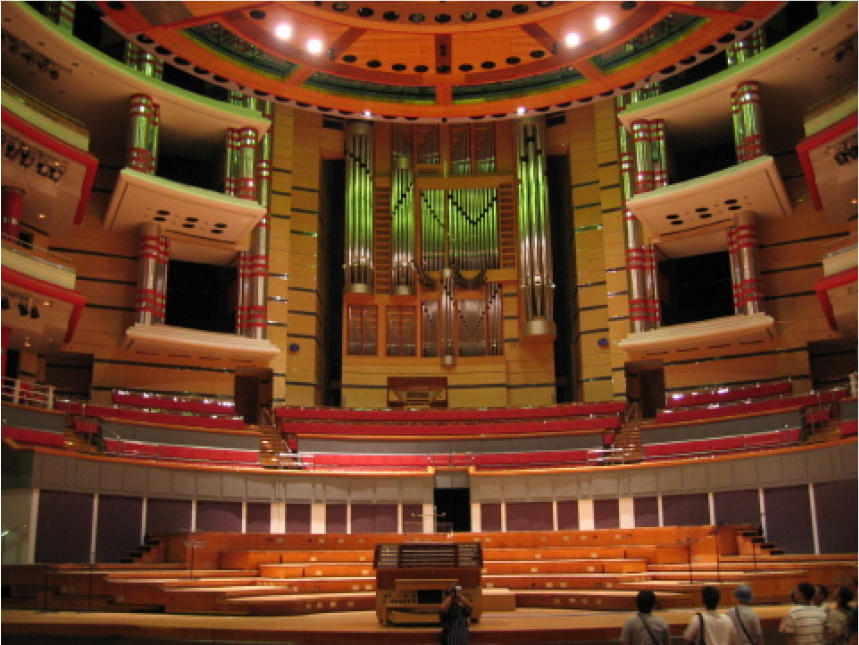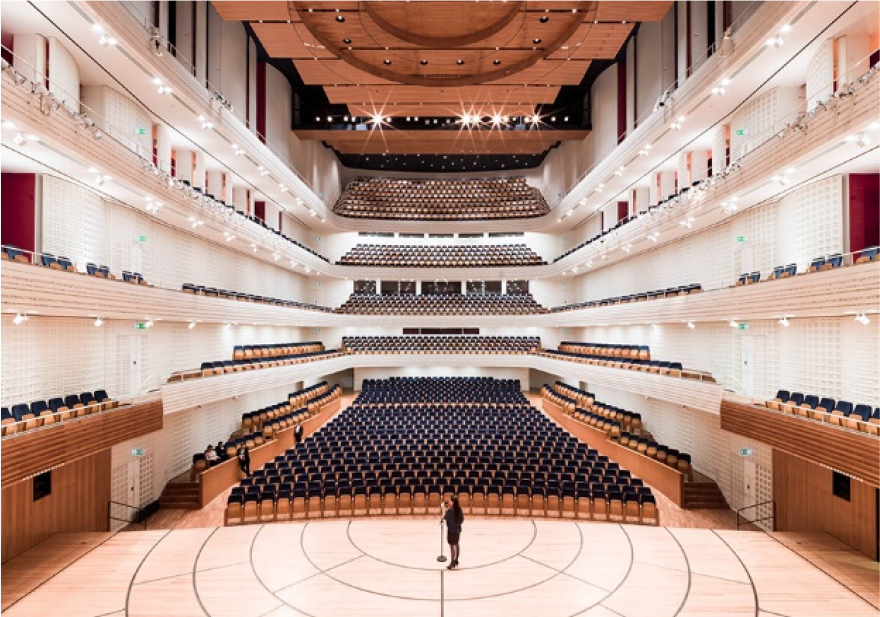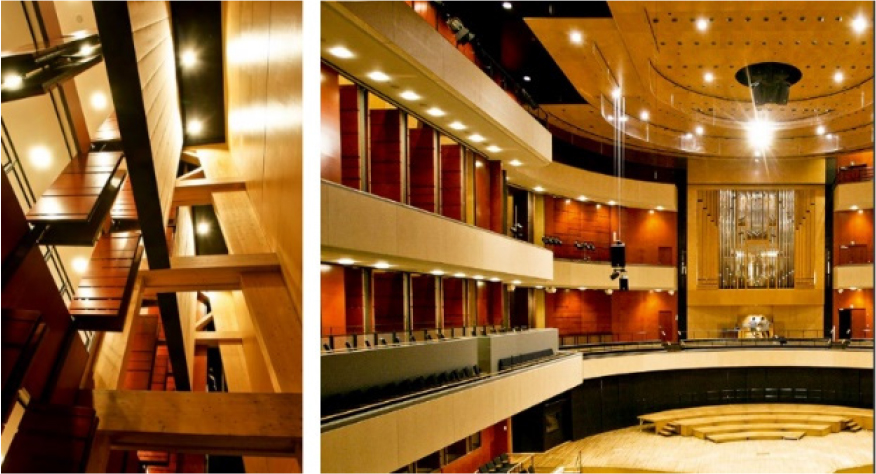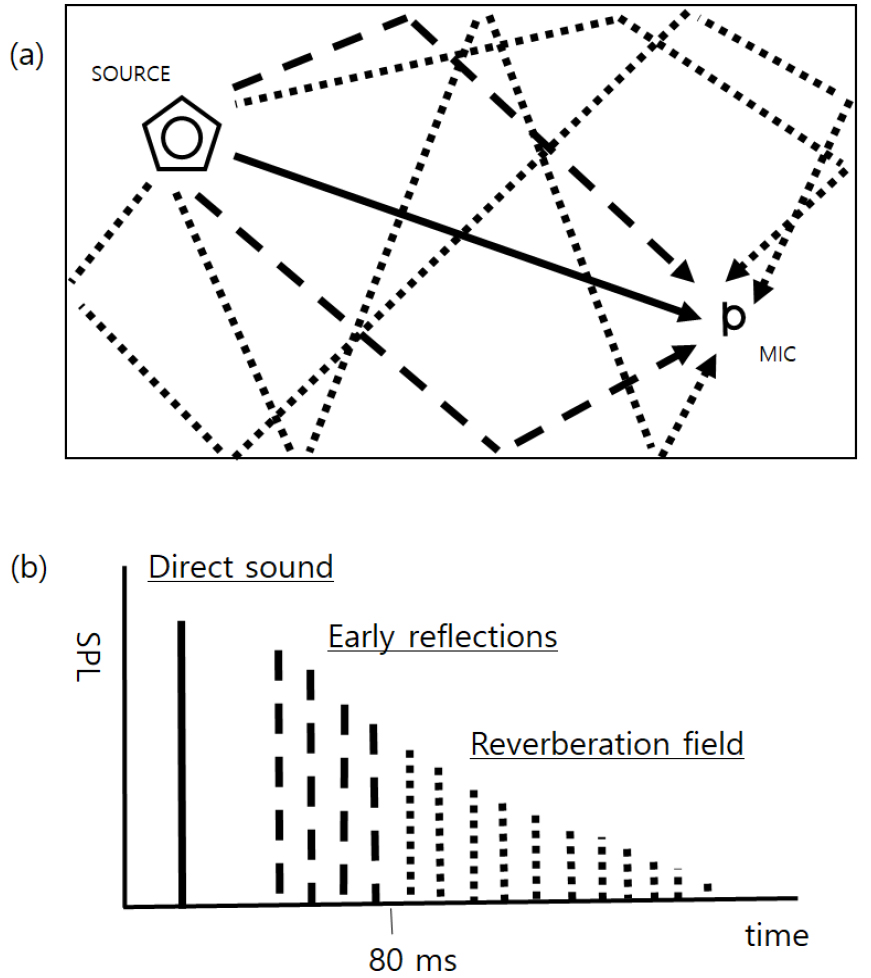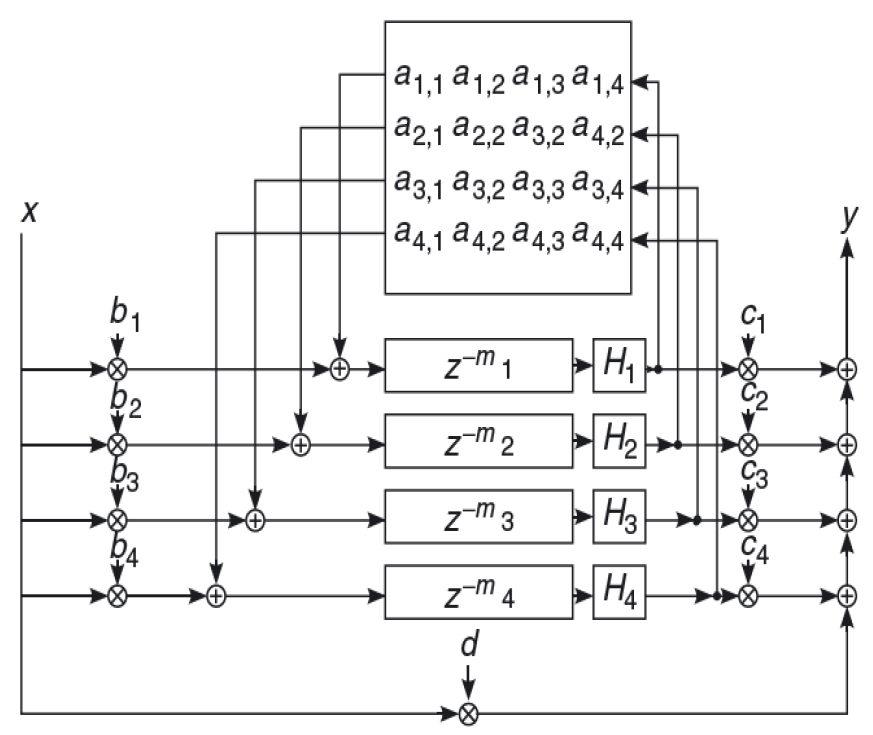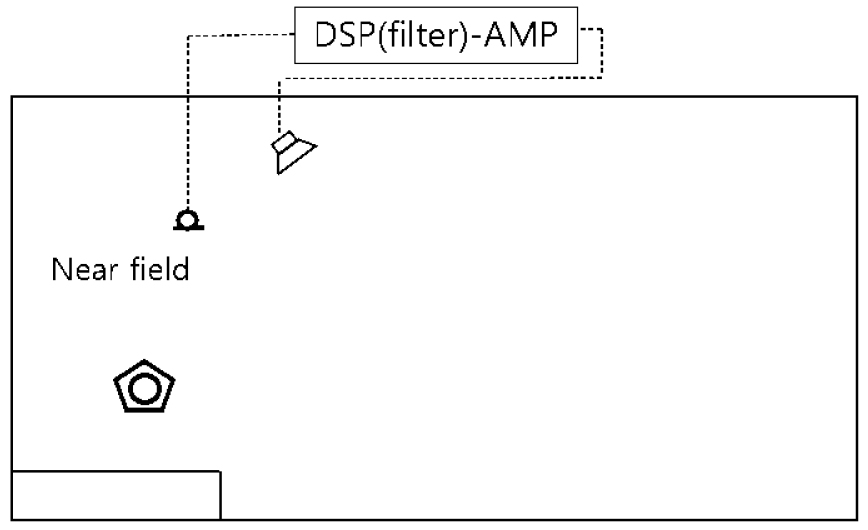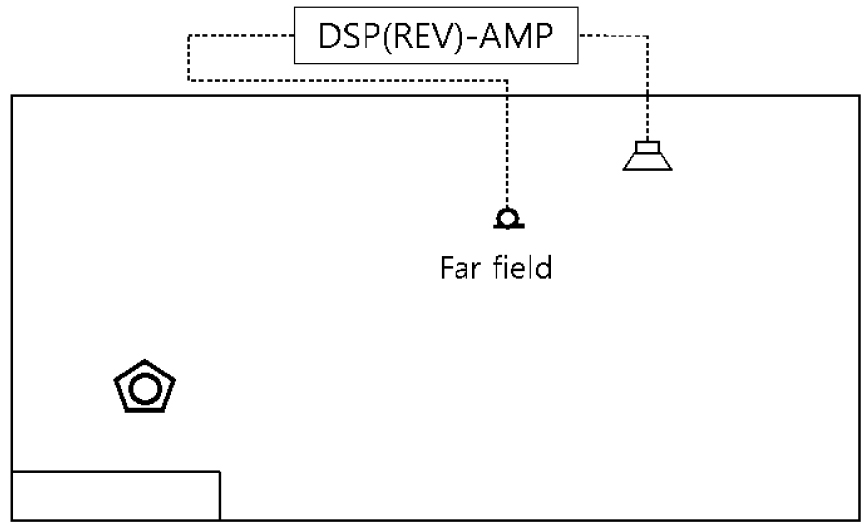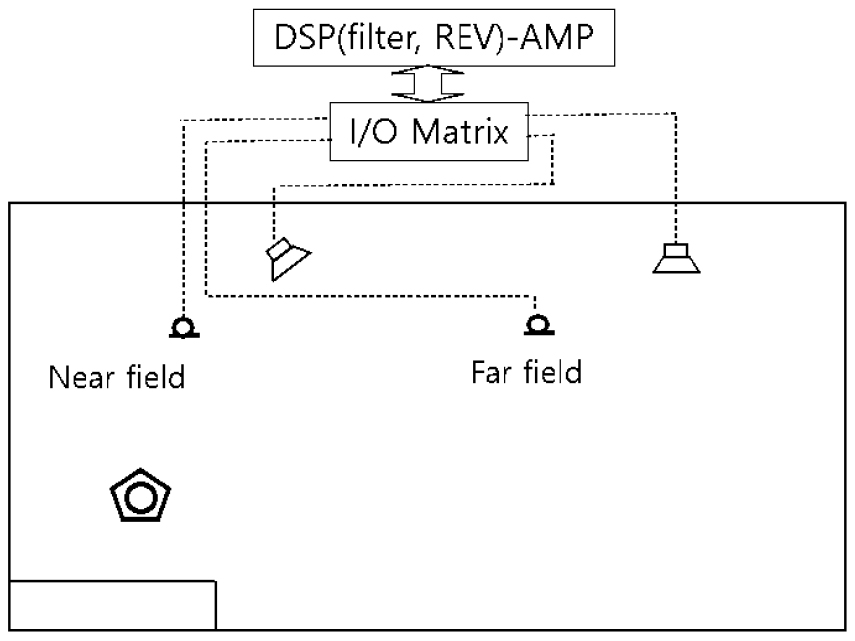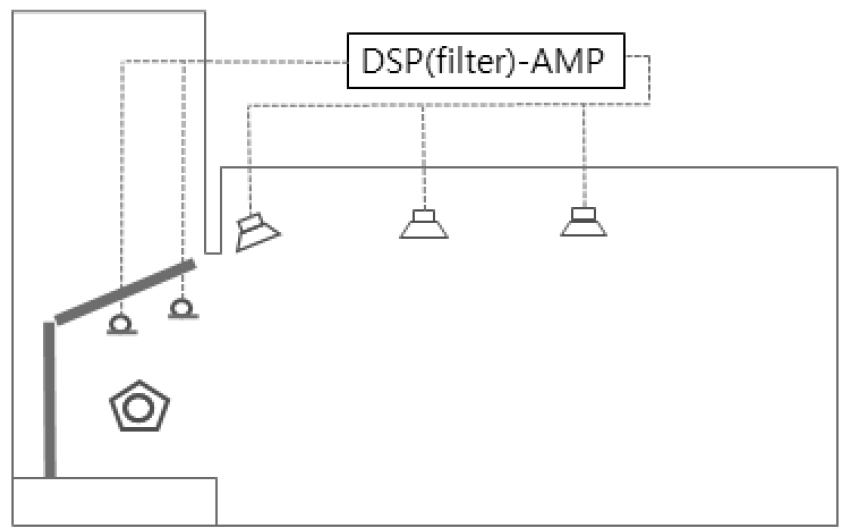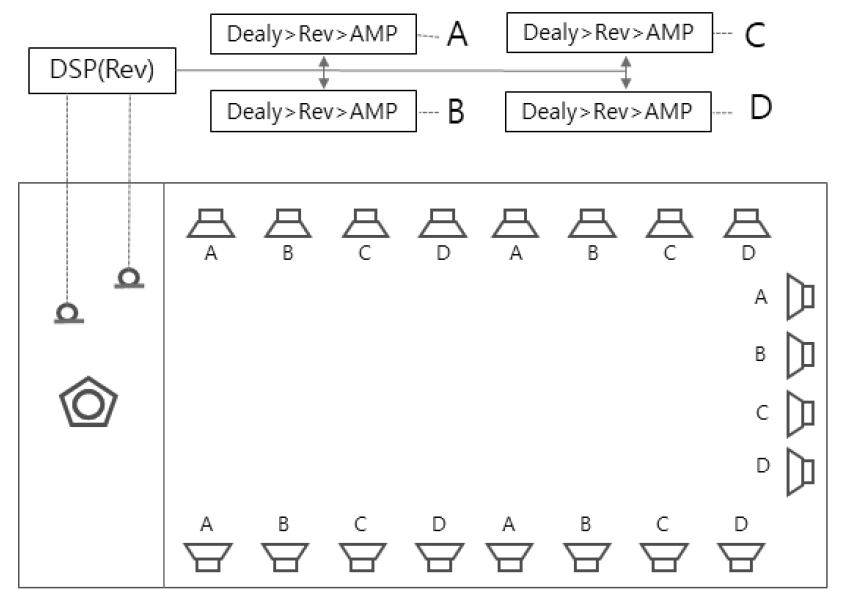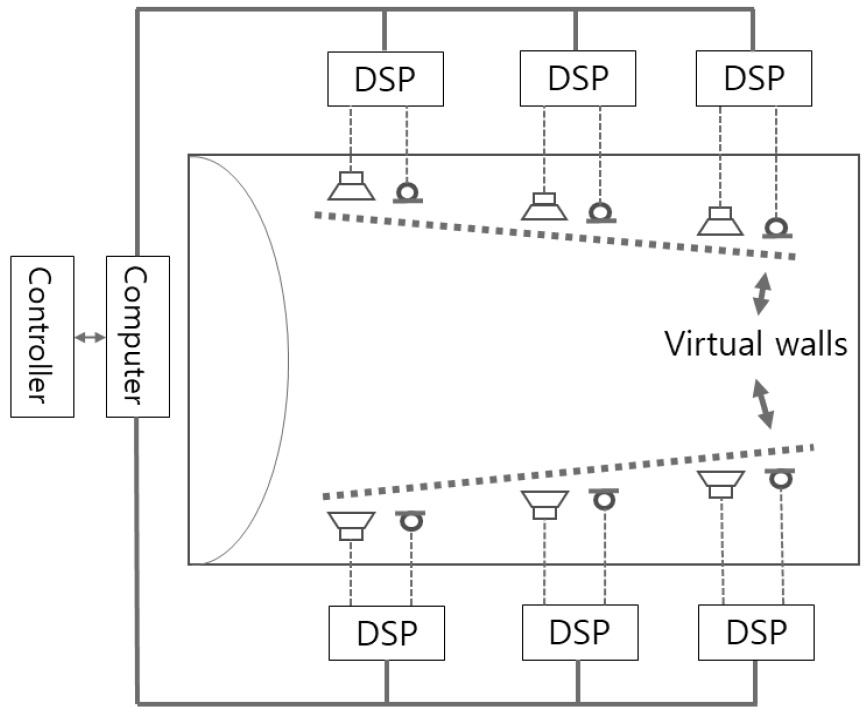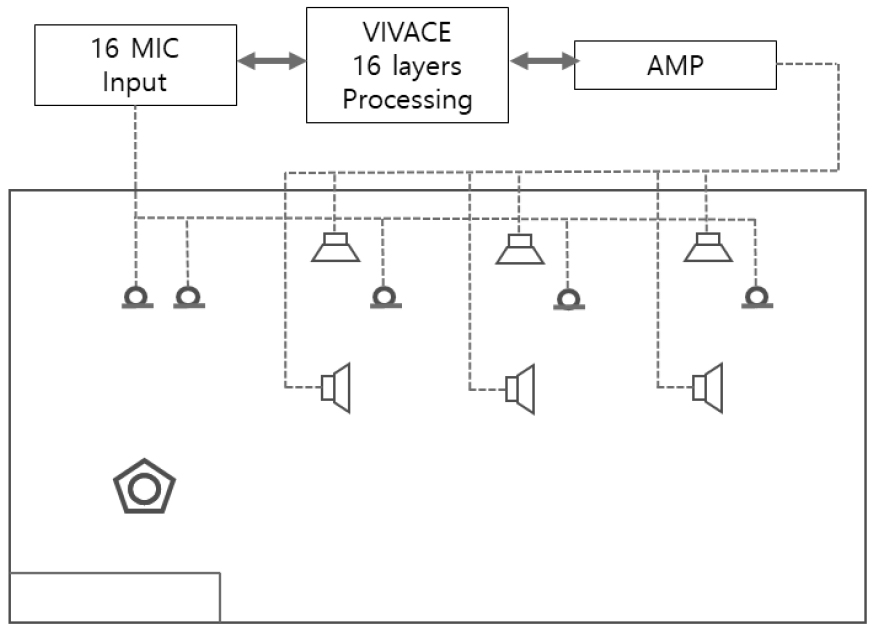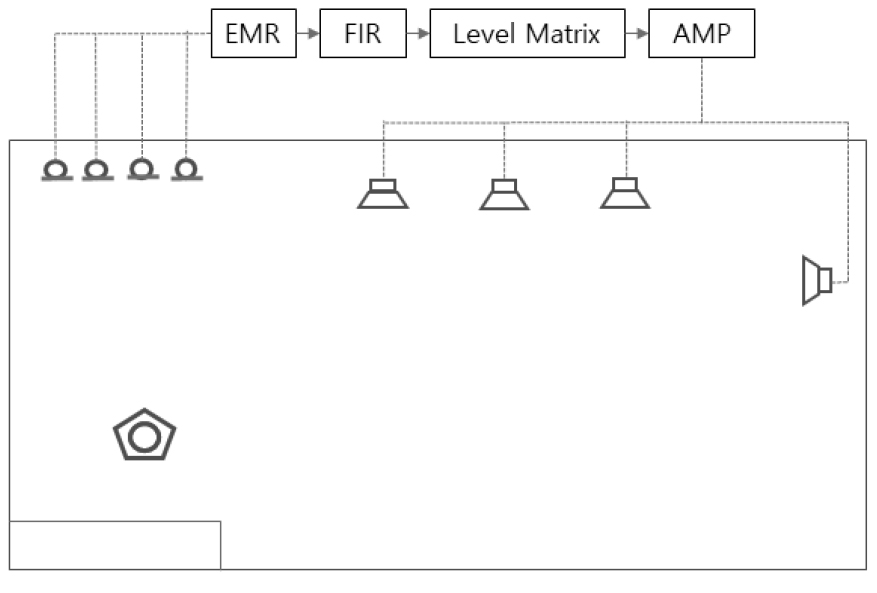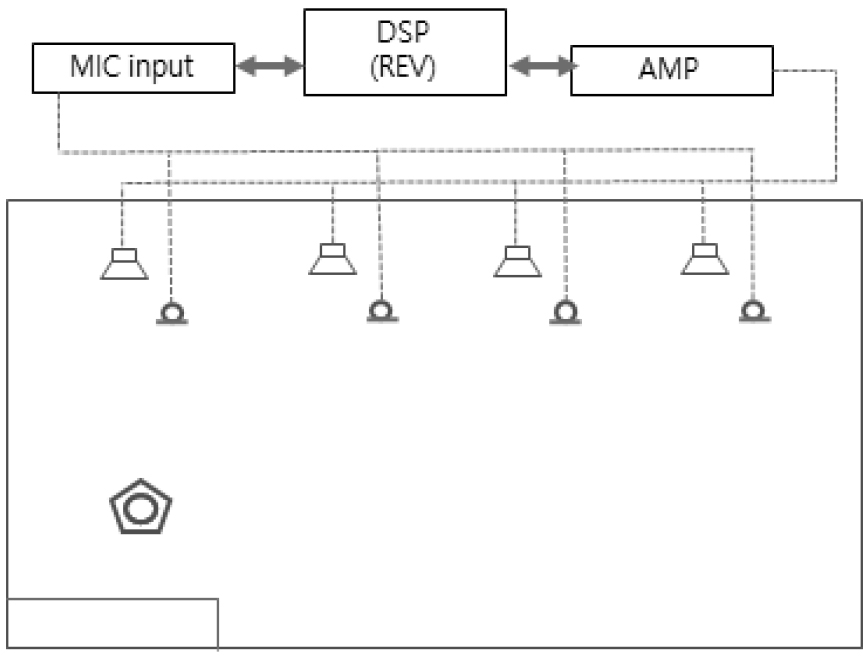I. Introduction
II. Passive control of room acoustics
2.1 Variable absorption
2.2 Variable volume
2.3 Coupled volume
2.4 Canopy reflector
III. Active control of room acoustics
3.1 The concept of artificial reverberation
3.2 The type of active acoustic system
3.3 Case studies
IV. Concluding remarks
I. Introduction
Seoul Art Center concert hall, inaugurated in 1988, might be the first dedicated hall for music in Korea. Since then, a number of dedicated spaces for music, opera, or musical have been constructed and they are concentrated mainly on a few metropolitan cities. However, majority of small cities that can’t afford to secure such dedicated venues depended their cultural needs from local communities upon multi-purpose (or multi-functional) spaces. Cultural & art centers have taken this role for the last two decades. They have been used for covering wide range of cultural activities, such as public assembly, lecture, music performance of various genre (classical music, Korean traditional music, and rock concert), exhibition, and movie theatre.[1] As can be seen in Fig. 1, the growth in the number of registered performance venues is remarkable and the number of cultural & art centers reaches up to 256 in the year of 2020.[2]

Fig. 1.
(Color available online) Number of registered performance venues and Cultural & Art centers in Korea.[3]
Unlike the versatile utilization of cultural & art centers, the satisfaction with the acoustic quality of those spaces is far beyond expectations. It is mainly due to the fact that users are required to adapt to the acoustics of the space rather than the acoustics of the space responds to the need of the users from an acoustic point of view.
Even in a dedicated room for music, a certain degree of variability in room acoustics is indispensable, as the preferred room acoustic conditions are highly dependent on its genre played. As is shown in Table 1 which summarizes recommended occupied reverberation times for various types of performances, even a concert hall should be able to provide a certain degree of flexibility to meet the needs of both performers and audiences. Fig. 2 presents recommended reverberation times for amplified acoustic contents depending on the volume of a space, which implicates it is desirable to be equipped with a way to control at least reverberance of a room where electric amplification forms the main way of delivering sounds to audience.
Table 1.
Recommended occupied reverberation times at mid frequencies (500 Hz - 1,000 Hz) depending on performance genres.
| Type of performance | Reverberation time (s) |
| Organ[4] | >2.5 |
| Romantic classical[4] | 1.8-2.2 |
| Early classical[4] | 1.6-1.8 |
| Opera[4] | 1.3-1.8 |
| Chamber[4] | 1.4-1.7 |
| Korean traditional music (Pansori[5]/Gugak orchestral[6]) | 0.9-1.2/1.7 |
| Drama (spoken word)[4] | 0.7-1.0 |
Variable acoustics provide a means of adapting a space to a specific acoustic content in a multipurpose space (or specific musical piece in a concert hall). The most common expression of variable acoustics allows for a range of reverberation times.[9] Variable sound absorbing banners, curtains, and panels have been incorporated into many performing arts facilities over the past three decades. Recently, several halls have been completed that make use of partially coupled reverberation chambers to increase the level and/or length of reverberance without changing the basic shape, dimensions, or materials in the audience chamber. These are classified as passive systems for variable acoustics. Active systems refer to a system that adjusts reverberation time using electronic devices using multiple microphones, power amplifiers, loudspeakers, and signal processing devices. The present work tries to activate correct uses of variable acoustics in multipurpose performance venues through a better understanding of various variable acoustic control systems.
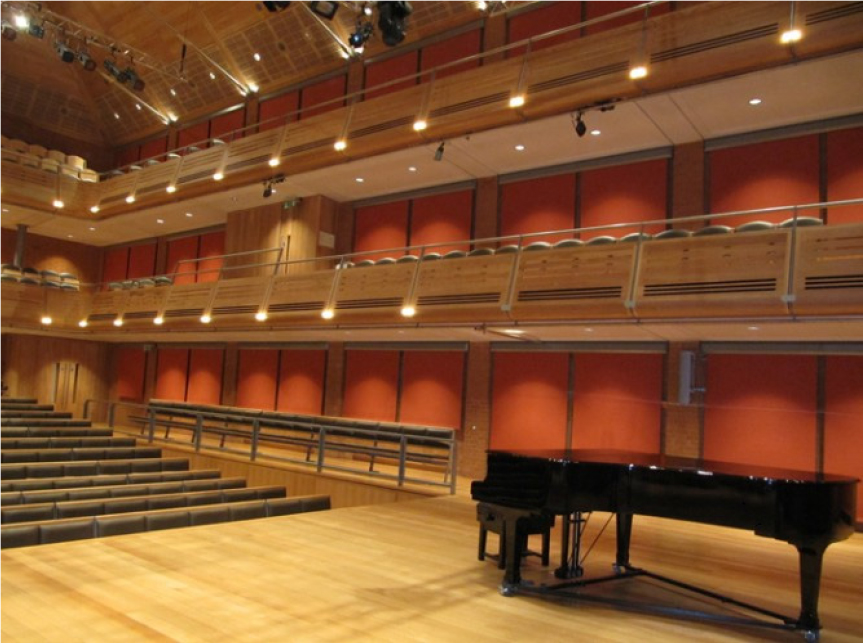
Fig. 3.
(Color available online) Examples of acoustic roller banner, installed along the sidewalls.[11]
II. Passive control of room acoustics
2.1 Variable absorption
One of the most frequently employed methods of adjusting the room acoustics of performance venues is the temporary introduction of additional sound absorption. The simplest and relatively inexpensive way of varying absorption might be the retractable sound-absorbing banners or heavy curtains deployed to reduce the reverberation time, or retracted to increase it. Banners are generally implemented in the form of fabric surfaces placed vertically or horizontally along the walls of auditoriums (Fig. 3). In practice, one or two layers of heavyweight fabrics are used, characterized by a high value of the sound absorption coefficient. Simplified methods of designing acoustic banners assume estimating the effectiveness of adjusting the reverberation time on the basis of the static theory. They have a strong variability of sound absorption in mid and high frequency ranges due to the materiality of banners and curtains.[10]
Sometimes, architects and operators of venues are reluctant to employ banners or heavy curtains because of its heterogeneous appearance compared with existing room surfaces. Banners combined with acoustically transparent materials can be a good compromise in such occasion. The new LG art center (to be built in magokdong, Seoul) adopted room finish consisted of an acoustically transparent material (woven mesh) with a large air gap to allow for a Variable Absorption System (VABS) to be deployed. The banners are stored within fixed boxes mounted on the ceiling. When the banners are retracted, they will be completely boxed in by a closing panel located at the bottom of the box. When in use the banners are lowered from the boxes and will hang either on the side walls behind the acoustically transparent finish.[12]
Alternately, sound-absorbing panels slide away to reveal a sound-reflecting or sound-diffusing panel behind them, and slide back when reflections are preferred instead. Fig. 4 shows an example of movable sound absorbing panels installed along the rear walls of side balconies in the Symphony hall, Birmingham, UK. When not in use, they are placed in the storage and moved into the hall along the rail installed on the ceiling to reduce reverberation.
Other schemes feature double sided hinged (Fig. 5) or rotating panel absorbers (Fig. 6), in which one side reflective and other side sound absorptive. Triple sided variable absorbers composed of rotating triangular wedges with one side reflective, one side sound absorptive and a third sound diffusive have been used in L’Espace de projection of IRCAM. Each prism element was designed to be independently rotatable (Fig. 7). The reverberation times of this facility could be extended up to 4 s along with its variability in room volume and shortened below 1 second by facing absorptive side of prisms into the room.[13]
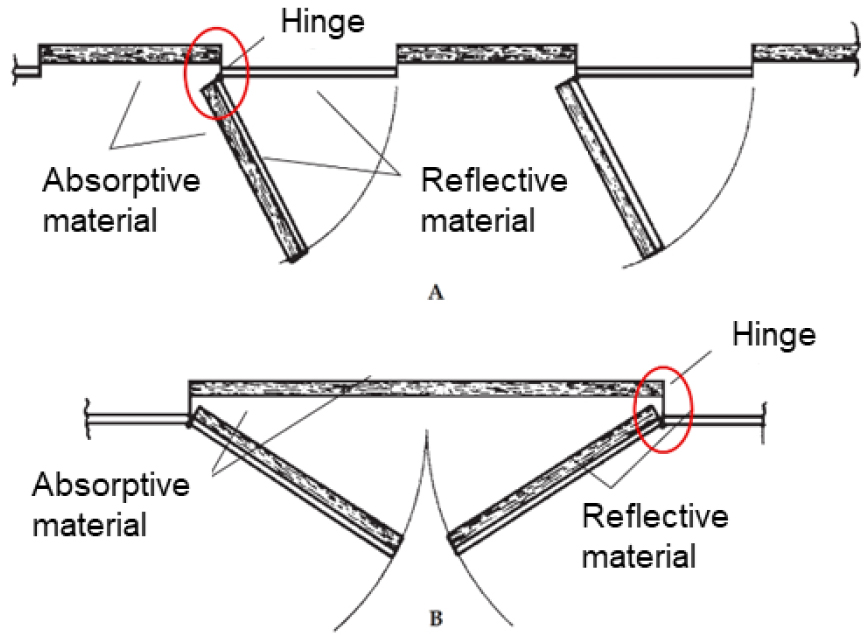
Fig. 5.
(Color available online) Examples of hinged panels, reflective on one side and absorbent on the other. (a) Single hinged panels, (b) double hinged panels (after Everest[14]).
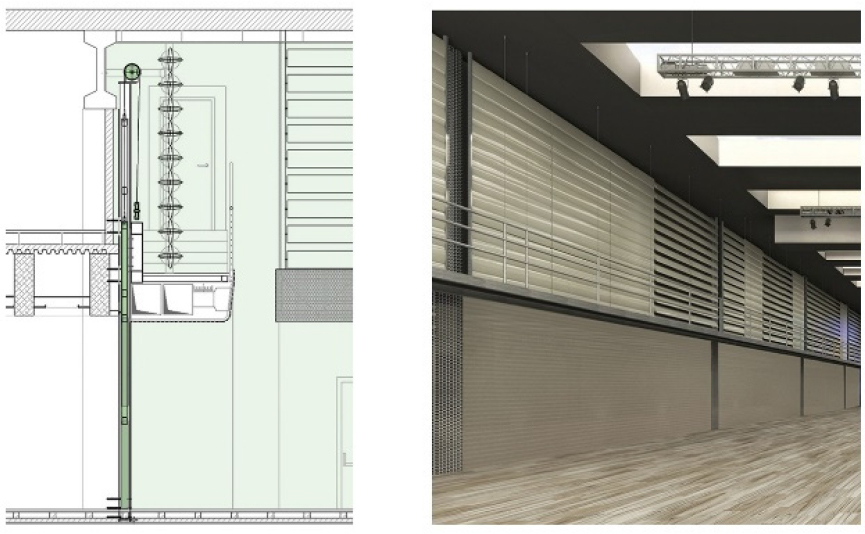
Fig. 6.
(Color available online) Rotating panel absorbers, installed in the auditorium Calzedonia (after Cairoli[15]).

Fig. 7.
(Color available online) L’Espace de projection and rotating prism installed. Above: Inside view from the stage. Below: Possible configurations obtained by rotating prisms (after Shtrephi et al.[16]).
Double sided rotating cylinder is one of this type. The half of the cylinder surface is made from hard and fully reflective materials, and the other half is highly absorptive (Fig. 8).
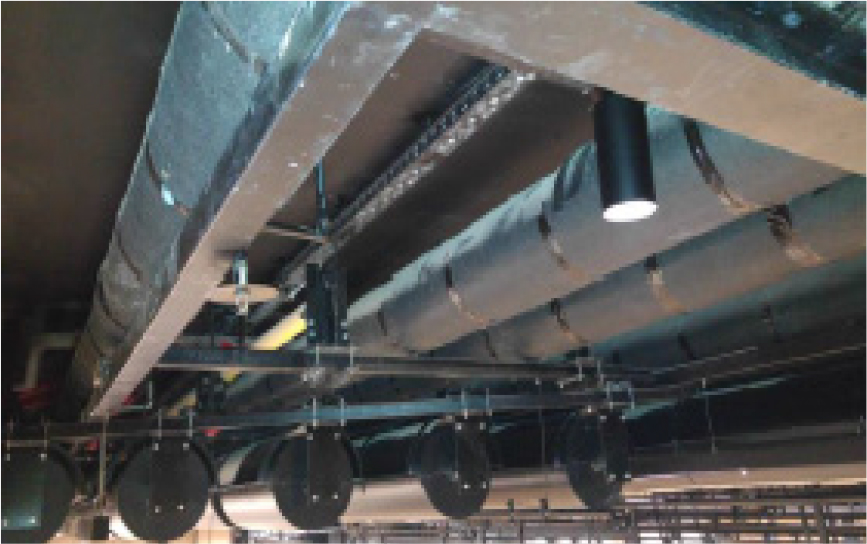
Fig. 8.
(Color available online) Rotating cylinders installed on the concert hall (the Academy of Music in Zagreb) ceiling (lower part of the figure) for changeable acoustics (after Jambrošić[19]).
The sound absorption of majority of variable sound absorbers reviewed above concentrates on mid and high frequency ranges as their fabrication are highly dependent on porous absorbers. However, this type of variable absorbers may not be suitable for amplified music performance which require controlling reverberance at low frequencies. Recent researches on suitable acoustics for amplified pop and rock performance[17,18] reported that the reduction of reverberation times has to be achieved at low frequencies, most noticeably in the 125 Hz octave band, while high frequency reverberation times should be decreased less. A variable broadband absorption product (Fig. 9) is developed for amplified music which requires a significantly lower value of T30 in the 63 Hz, 125 Hz and 250 Hz octave bands. Absorption coefficients are approximately 0.8 in the 125 Hz, 250 Hz, and 500 Hz bands, 0.6 kHz at 1 kHz and decreasing at higher frequencies and in the 63 Hz band when in the ON position. In the OFF position the product attains absorption values between 0.0 and 0.2 (Fig. 10).[20,21]
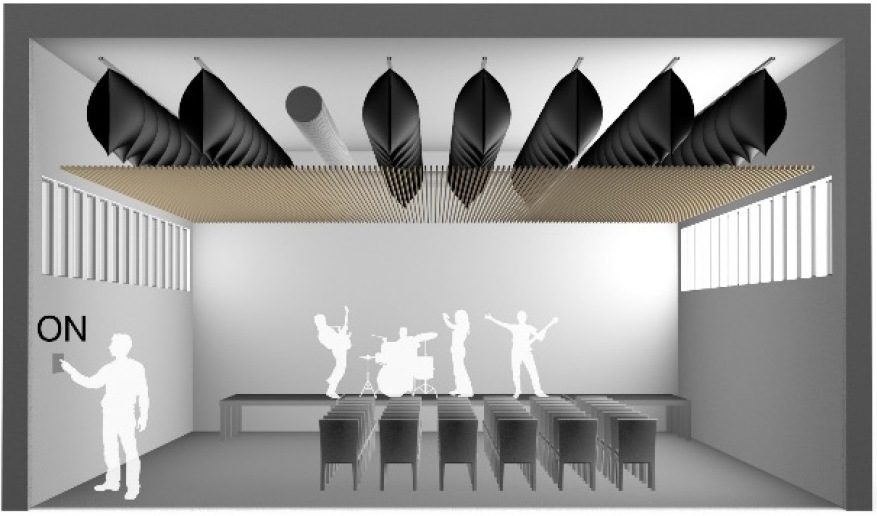
Fig. 9.
(Color available online) Examples of inflatable absorbers, installed on the ceiling (after N. W. Adelman- Larsen[20]).
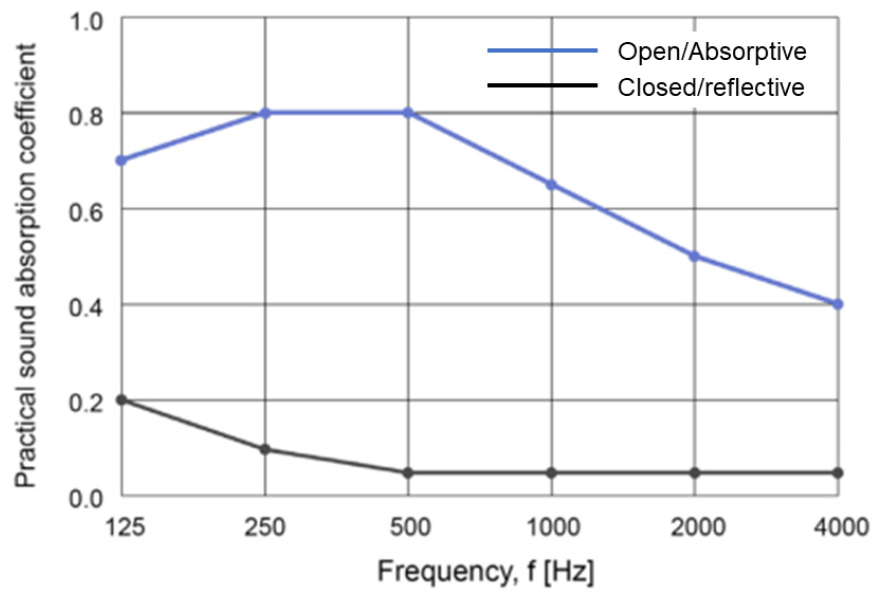
Fig. 10.
(Color available online) The sound absorption coefficients of wide band variable absorber (after Adelman-Larsen[22]).
These passive systems allow the building users to reduce the level and/or length of the reverberance from what would be the basic decay of the room. These systems are typically used to provide a dry acoustical environment for sound system use and some portions of the classical repertoire. In each case, the room’s operator or the orchestra conductor decides which type of surfaces to be used. Adding absorption is simpler and is potentially equally good but the amount of absorption necessary to make useful changes is extensive.[23] Also, the possibility of tuning the interior acoustics need to be verified depending on the position of the banner in the room as well as the degree of its opening. In a concert hall where lateral reflection plays a significant role, care should be taken in placing banners on side walls.
2.2 Variable volume
Acoustics of a room can be varied by changing the volume of the space and typically moving a ceiling vertically is preferred. Changing the volume is a particularly effective method for changing the reverberation time. One of the biggest advantages is that the loss of sound level can be kept minimal. However, providing large changes in auditorium volume requires ingenuity in terms of both architectural design and theatre engineering.[23] An effective solution for providing variable acoustics is a combination of changes in auditorium volume and changes in absorption. This concept has been used in many multipurpose auditoriums.
Jesse Jones performing arts hall is one of early multipurpose space where variable volume along with adjusting room absorptions plays a significant role in varying acoustics (Fig. 11). This multipurpose hall, opened in October 1966, is expected to accommodate the full range of musical and theatrical events. The ceiling of the hall consists of an array of hexagon-shaped damped steel panels that can be moved in groups to adjust the hall’s seating capacity and its acoustical environment. The upper balcony is excluded by lowering the ceiling and results in reducing the seating capacity from 3,000 to 2,400. The seating capacity is reduced by mesh curtains toward the rear mezzanine and orchestra level reduce the seating capacity to 1,800, which is for drama configuration. The reverberation time of the hall at mid frequencies is 1.8 s in the symphony and opera configurations (3,000 seats) and 1.4 s in the drama configuration (1,800 or 2,400 seats, all draperies exposed).[23]
Milton Keynes Theatre in Buckinghamshire, UK is a multipurpose cater for performances of drama, musicals, opera, ballet and classical music. To accommodate wide range of performances, the movable ceiling is adopted as the fundamental mechanism for changing acoustics. Also, extra variable absorptions are provided by movable drapes on the sidewalls. Fig. 12 presents a section through the auditorium showing three pre-determined heights for the moving ceiling (for chamber & concert, lyric, and drama, respectively). The distance between the maximum and minimum heights is 10 m. For orchestral music, the ceiling is in its highest position and all the drapes are retracted. This configuration provides a volume of 8.5 m³ per seat and gives maximum reverberance. The mid-frequency reverberation time is 1.6 s. The intermediate ceiling height provides a lyric theatre suitable for opera and musicals, and the volume per seat is 6 m³. For opera, the drapes remain retracted resulting in a reverberation time of 1.25 s. For musicals the drapes are extended to reduce reverberance for amplified sound. The lowest ceiling position cuts off the highest balcony reducing the seating capacity to 980. The resulting volume per seat is 4.5 m³ and with the drapes extended, the measured reverberation time is 1 s (for drama).[24]
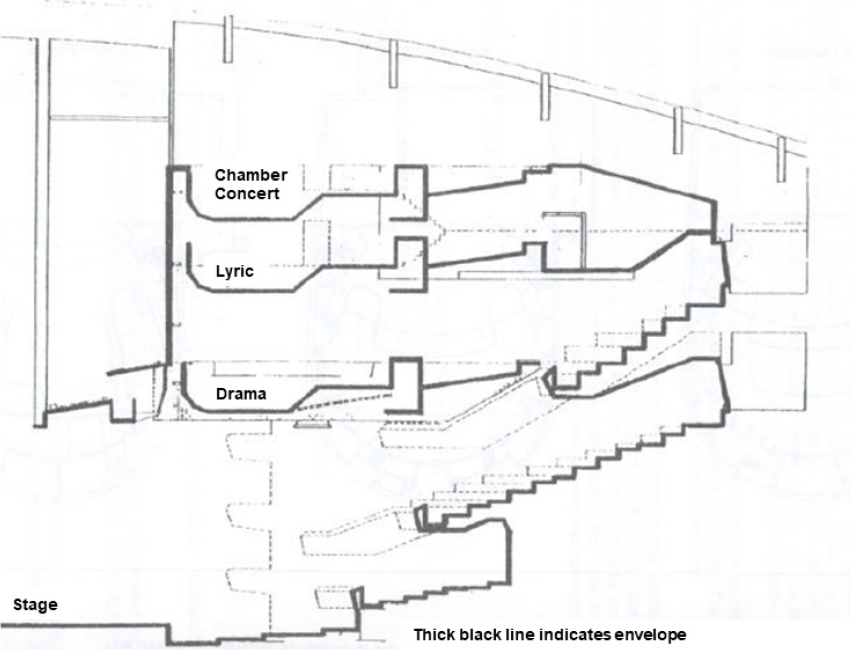
Fig. 12.
Variable volume control in Milton Keynes Theatre (Buckinghamshire, UK). Section through the auditorium showing the three heights of the moving ceiling (after Orlowski[24]).
In Sala Sao Paulo, Brazil, the ceiling consists of 45 rectangular plates organized in a matrix of 59 with each group of three plates moving independently (Fig. 13). 15 ceiling elements can be displaced in a range of 20 m, which provides a great diversity of volumes and forms are available to tune the room according to the musical performance options. Tenenbaum et al. measured the effect of seven roof configurations cases on the room acoustics and found that both reverberance and music clarity were significantly influenced by the configuration (in between romantic and classical halls).[26]
Recently built Fartein Valen hall, Norway (Fig. 14) adopted a similar approach to those reviewed above for the design of acoustically flexible hall. Fartein Valen hall is optimized for acoustic music performance. Variable acoustics is realized by a movable acoustic ceiling made up of eight elements, up to 30 tons each. The height of the movable ceiling is varied between 17 m (lowest) and 22 m (highest) (Table 2). Other elements for variable acoustics are movable canopy reflectors, motorized absorptive curtains on tracks along the side walls, and vertically deployable absorptive curtains coming out of the movable ceiling.[29] Acoustic curtains were installed on motorized curtain tracks along the side walls of the concert hall, and these curtains allow for a lower reverberation time for amplified events and brass band concerts.
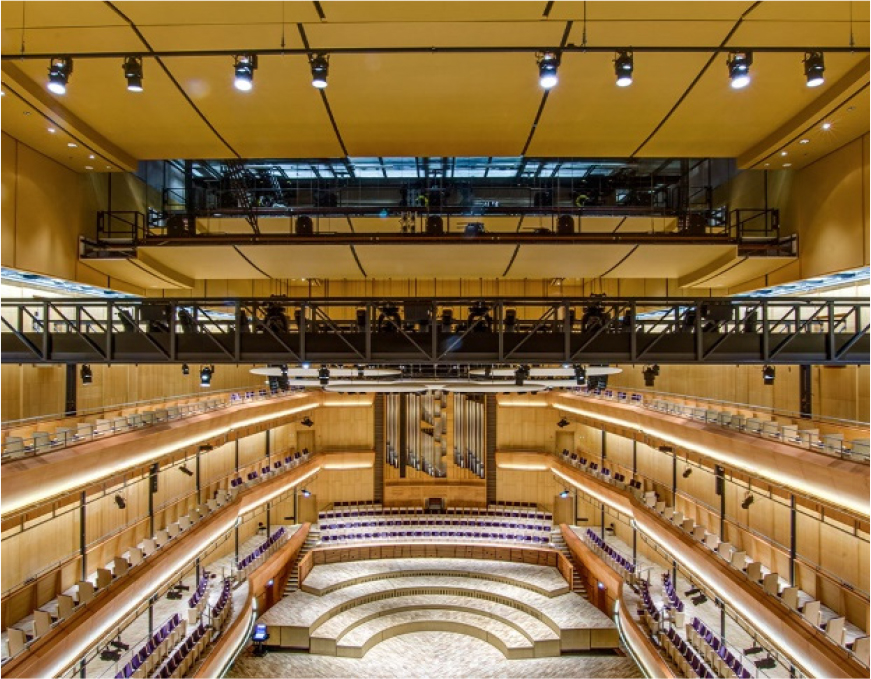
Fig. 14.
(Color available online) Fartein Valen hall, Norway, movable acoustic ceiling with 8 elements, up to 30 tons each.[27]
Table 2.
Ceiling height changes and resulting room volume in Fartein Valen hall, Norway.[28]
| Ceiling height (m) | Volume (m3) | Volume per person (m3/person) |
| Lowest (~17) | 16,000 m3 | 10.5 |
| Highest (~22) | 20,000 m3 | 13.3 |
Apart from the halls reviewed in this section, a movable ceiling system has been utilized to provide an acoustic variability in a number of halls, such as Gulbenkian Great Hall[30] (Lisbon, Portugal), Segerstrom concert hall[31] (Costa Mesa, USA), Bruce Mason theatre[32] (Oakland, NewZealand), Kani public Arts Center large hall[33] (Kani, Japan), Theatre De Spiegel[34] (Zwolle, Netherlands), and more.
Even though the variable volume system has been used in many halls, mostly it is accompanied by other variable elements such as variable absorptive banners or curtains. As, Möller et al.[35] pointed out that the movable ceiling system inevitably requires quite large constructions and added building volume, and thus add considerably to the cost of the building. In a shoebox hall with a floor area of 20 m by 40 m, a change of 20 % of the reverberation time requires the ceiling to move 3.5 m ~ 4 m.
2.3 Coupled volume
Coupled volume refers to having an attached volume which is coupled to the main room through doors or apertures. There are mainly two types of acoustical coupling which are source-area coupling (stage house coupling) and distributed coupling (reverberation chambers). In source- area coupling source is in the auxiliary room and auxiliary room is the stage and stage tower above. In coupled volume system, three architectural parameters are found to play a significant role in controlling the acoustics of main room: the volume ratio between the main and secondary spaces, the absorption ratio between the two spaces, and the aperture size.[36,37,38]
One of representative example of stage house coupling might be vaudeville/ movie houses. In the nineteen sixties when many orchestras in the North America were playing in vaudeville/ movie houses that were built in the nineteen twenties and thirties. In those spaces, the stage house has been used as the coupled space which have the longer reverberation times but with relatively smaller volumes than those in present. So-called, ‘concert hall shaper’, an adaptation of the techniques used earlier for the presentation of orchestras in the smaller volume stage houses of the old vaudeville/movie theatres (Fig. 15) is utilized in a number of halls (Hall C at the Tokyo International Forum, the Bass Hall in Fort Worth Texas, and Oklahoma Civic Center Music Hall in Oklahoma city).[39] The concert hall shaper refers to a second ceiling that is positioned in the stage house which blocks off the upper volume of the stage house leaving a lower volume of 7,000 m3, an amount similar to the volume of the old vaudeville theatres.
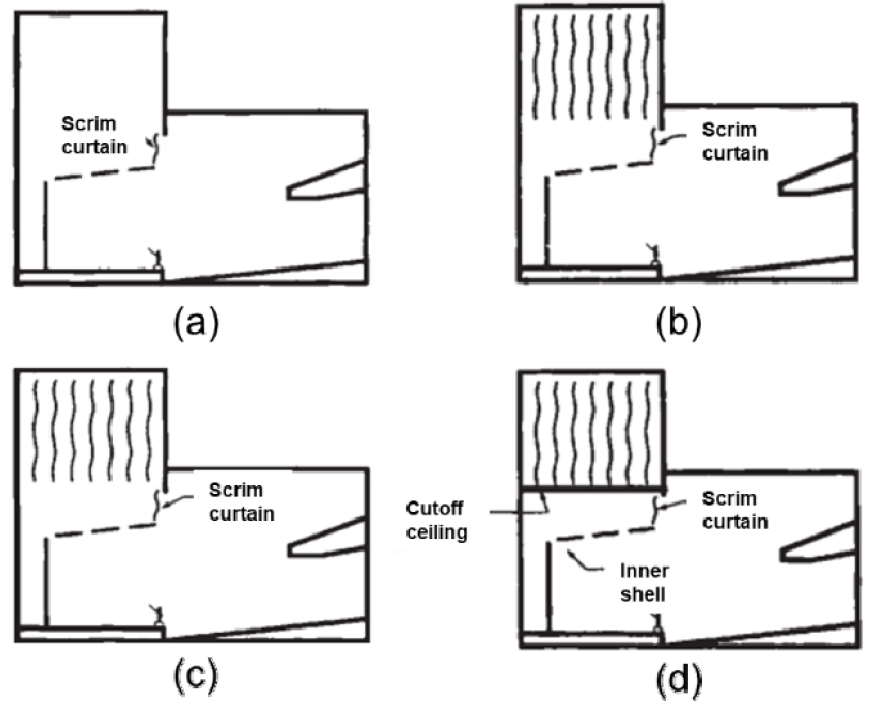
Fig. 15.
Sketch of tunable shell in Vaudeville stagehouse with and without concert hall shaper: (a) Coupled stage house-low volume hall with no draperies, (b) coupled stage house-low volume hall with draperies, (c) coupled stage house-low volume hall with no drapes, (d) coupled stage house-low volume hall with draperies and cut-off ceiling (after Jaffe[39]).
Groβes Haus Staatstheater (Mainz, Germany) was renovated for 4 varying uses (concert, opera, ballet, and theater) (Fig. 16). A flat response of the enclosure between 63 Hz ~ 4,000 Hz is intended for accommodating these heterogenous uses by installing low frequency absorbers in both auditorium and stage tower. By coupling the volume of stage tower, twice as large as that of main auditoria, T60 in the auditorium is kept almost constant around 1.4 s (for opera use,). For concert use T60 is raised up to 1.7 ± 10 % by obstructing the transmission of sounds using orchestra shell.[40]
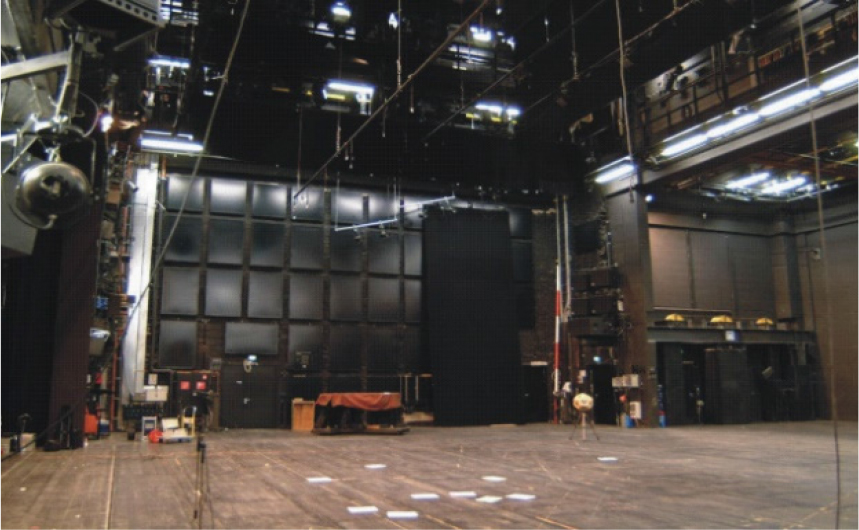
Fig. 16.
(Color available online) Low-frequency absorbers installed the hard surfaces of the stage tower in Groβes Haus Staatstheater (after Zha[40]).
On the other hand, several halls have been constructed for the last decade that make use of distributed coupling (partially coupled reverberation chambers) to increase the level and/or length of reverberation without changing the basic shape, dimensions, or materials in the audience chamber. With operable shutters at the boundary between the audience chamber and reverberation chamber and with sound absorbing curtains in the reverberation chamber, the overall reverberant decay can be tailored to provide a long decay without significant decrease in clarity.[41] This arrangement, however, unavoidably resulted in a double- decay sloped reverberation which is regarded as an acoustics failure in the past prior to 1970’s. Nowadays, growing attentions are paid by acoustic practitioners and researchers to the possibility of getting both clarity and reverberance using this concept.[42]
Nowadays, there exist a growing number of halls using this concept. Birmingham Symphony Hall (Birmingham, UK), the Concert Hall in the KKL Luzern (Lucerne, Switzerland), Sibelius Hall (Lahti, Finland), and Heydar Aliyev Center Auditorium (Baku, Azerbaijan) and many other halls fall into this group.
The Symphony Hall, Birmingham is a dedicated concert hall which requires flexibility in covering from chamber music to pipe organ performance acoustically. For this purpose, it has a reverberation chamber behind the stage and extending high along the sides which amounts to 50 % of the hall’s volume, and the doors to which can be remotely opened or closed (Fig. 17). The U-shaped reverberation chamber area has a volume of 12,700 m3. Also, an acoustic canopy which can be raised or lowered above the stage supports acoustic variability in both audience and stage area. Dampening panels (Fig. 4) can be extended or retracted to ensure that the sound of the space is perfectly matched to the scale and style of the music to be performed.
The Concert Hall in Lucerne (Fig. 18) is the home of the International Music Festival and it is required for this hall to provide an appropriate acoustic environment for an even wider range of performances, ranging from conferences and other speech events to symphony orchestra, amplified popular music, ethnic music, and organ recitals.[44] For these wide range of usages, a reverberation chamber is incorporated along with variable absorptions. The volume of the audience chamber is about 18,000 m3 (10 m3/ person). The reverberation chamber surrounding the audience chamber adds about 6,000 m3 to the primary volume. Depending on the specific settings of the reverberance chamber doors (different couplings between the inner volume of the audience chamber and the outer volume of the reverberance chamber), the reverberation time with a full audience can be varied between about 1.6 s and 3.0 s at mid-frequencies. The two‐part moving canopy with both horizontal and vertical reflecting surfaces helps improving intimacy and clarity of sounds in audience area and ensemble between performers on the stage. For speech events and other events which require a drier and more intelligibility, motorized, double-layer sound-absorbing curtains are deployed in front of most of the wall area.[45]
The coupled volume system is applied in another timber-built shoebox-shaped concert hall, Sibelius Hall (Fig. 19). As is observed in the previous examples, a three-piece adjustable acoustic canopy and adjustable absorption (banner and curtains) along with reverberation chamber are incorporated. The volume of audience chamber is about 18,000 m3 and total 7,000 m3 in volume of a reverberation chamber are acoustically coupled to the performance space through a series of reverberation chamber doors.[47] The number of open doors, the location of each open door and the degree of openness are researched at the acoustic design stage in order to achieve the desired acoustic for a wide range of repertoire. Adjustable acoustic control banners are in the reverberation chambers and adjustable acoustic control curtains are being installed along the walls of the inner audience chamber for facilitating the use of the sound system and for adjusting the room for musical events requiring a less reverberant environment. An adjustable height acoustic canopy in three sections is suspended above the performance platform to facilitate on-stage communication among musicians, to direct sound energy to seats in the center of the main floor.
The auditorium in Heydar Aliyev Cultural Center (Fig. 20) incorporates the challenge of providing multipurpose requirements of the hall, conference, concert and opera use. Unlike the three concert halls reviewed before, in which reverberation rooms are horizontally coupled to main auditorium, the reverberation room in this auditorium is vertically coupled to the main volume. It is likely that both acousticians and operators of the auditorium do not want to spoil the unique interior design of Zaha Hadid by applying other variable acoustic arrangements such as banners and curtains. Reserving certain amount of volume at the upper parts of the Heydar Aliyev Center Auditorium (above ceiling in between auditorium shell and roof/wall main structure) and aperture in desired dimensions are architectural measures that will enable acoustical designers to work with coupled rooms. The coupled room surfaces are left mostly reflective. The acoustical volume of the room is estimated to be 600 m³. The aperture opening is in the center of aperture surface and of area around 19 m² with a width of 2 m. Aperture size has an essential role in balancing the reverberation time distributions of the auditorium and coupled space. Subjective experiences of audience due to the location of reverberation chamber are in question within this auditorium.

Fig. 20.
(Color available online) Coupled volume installed at the upper parts of the Heydar Aliyev Center Auditorium (located above ceiling in between auditorium shell and roof/wall main structure) (after Sü-Gül[48]).
Table 3.
Configurations of coupled volume and target RTs depending on the required activity in the auditorium in Heydar Aliyev Cultural Center[48].
| Activity | Configuration of coupled volume | Target RTs (s) at mid-frequencies |
| Conference | 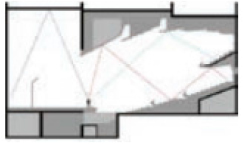 | 1.0 ~ 1.4 |
| Concert |  | 1.7 ~ 2.4 |
| Opera | 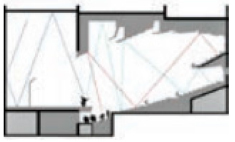 | 1.4 ~ 1.8 |
It is reported[49] that the reverberant sound is perceived as coming from above or hovering above the room in the Carol Morsani Hall (Festival Hall) where the chambers covered only the upper parts of the auditorium (Fig 21). Siebein recommends that the location of the chambers needs to not only surround the upper portion of the room, but also extend down the side, which allows the audience to perceive the sounds coming from all parts of the room.
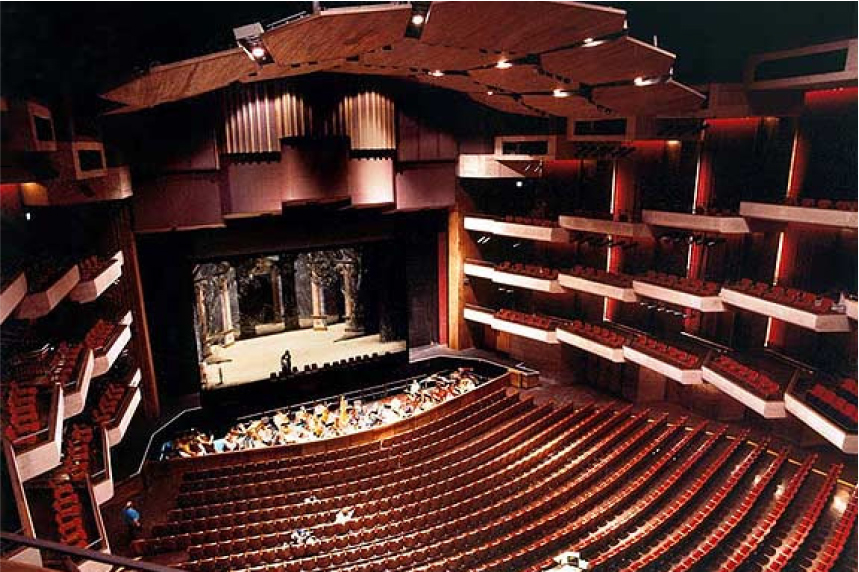
Fig. 21.
(Color available online) Coupled volume installed at the upper parts of the Carol Morsani Hall (Festival Hall) in Tampa.[50]
In acoustical coupling, to provide a sound field that is variable, longer, distinct, and performance-piece-specific depends on certain architectural parameters. Geometric volume, form, materiality and aperture size are variables that affect reverberation of sub-room and consequently energy flow to the main room. Achieving desired energy decay for performance specific purposes necessitates an intensive study on those variables throughout its entire design stages.
2.4 Canopy reflector
It is quite well-known that early reflections from room surfaces play a significant role in determining perceived acoustic quality of a space. Both the arrival time of early reflections after the direct sound and their intensities significantly influence listeners’ appreciations of room acoustics, such as intimacy, intelligibility, musical clarity, loudness and so on. Changing early reflections by reorientation or relocation of reflecting surfaces provides a very sensitive way of fine adjustments, while changing the volume of the space, and/or changing the amount of reverberant sound energy by the addition or removal of sound-absorbing materials are relatively insensitive in controlling room acoustics except reverberation times.[51,52] Acoustic canopy or canopy reflector is a large suspended reflecting structure installed on the ceiling (usually above the stage), controlling early reflections by adjusting the height of the structure. Acoustic canopies have been successfully used in many halls designed by Russell Johnson.
Suspended sound-reflecting panels, frequently appeared in BBN (Bolt Beranek and Newman) designed halls, may be the predecessor of an acoustic canopy. The first suspended sound-reflecting panels for specifically musical purposes were employed in the 1959-1960 renovation of the 5,000 seat “Music Shed” at Tanglewood, Lenox, Massachusetts (Fig. 22). The panels were intended to improve sound distribution and balance throughout the audience, improve clarity, and improve on-stage communication and they accomplished all these goals.[54] Fig. 23 represents an idealized concert hall with measures allowing the performer to adjust C80 (clarity index), to his or her satisfaction by a motorized overhead suspended panels or canopy and portable stand-alone reflectors. A wide range of C80 values should be possible in such a configuration without changing reverberation time appreciably.[55]
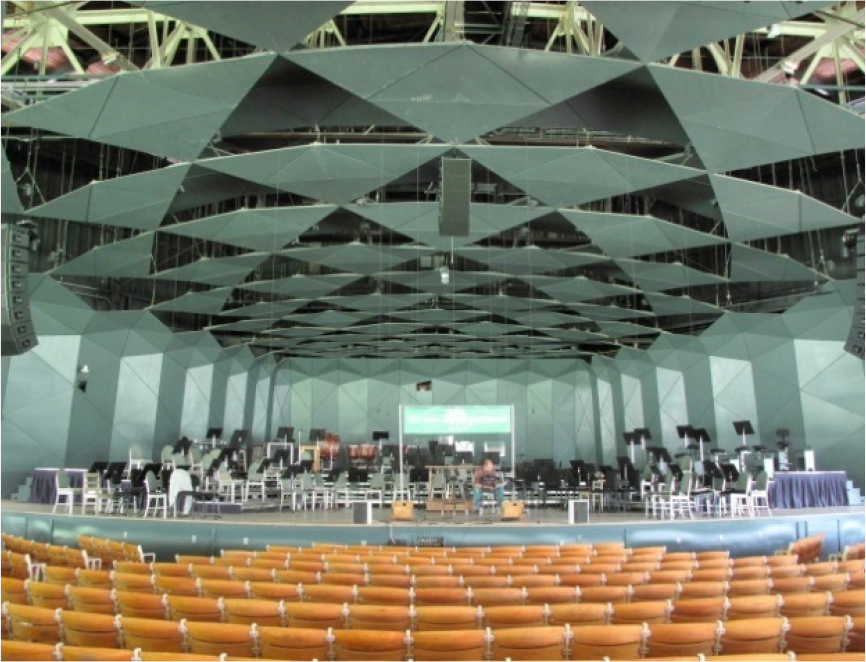
Fig. 22.
(Color available online) Music Shed at Tanglewood. Suspend sound reflecting panels are installed on the ceiling.[53]
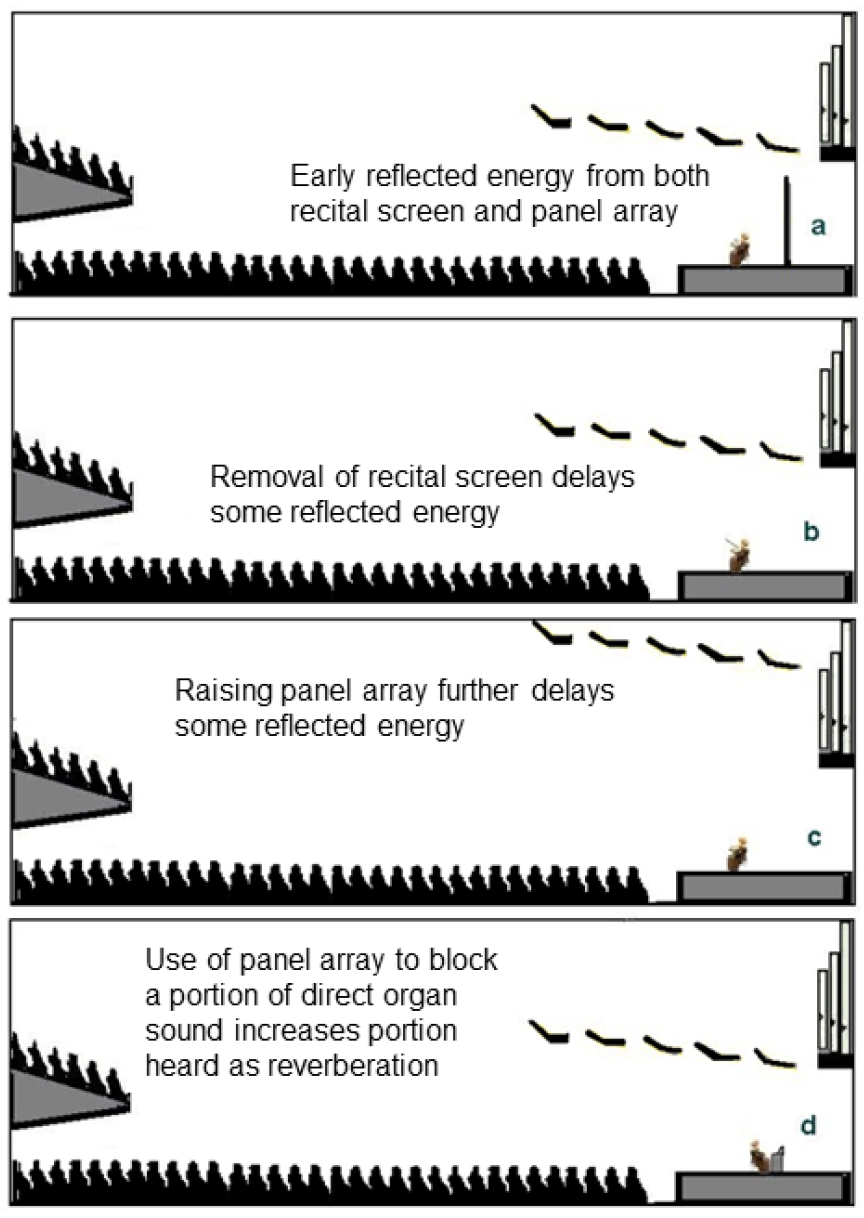
Fig. 23.
Varying clarity, C80 with a fixed reverberation time using suspended reflecting panels or canopy (after Klepper[55]).
Multiple specular reflector panels are also available for the creation of “hot spots,” allowing for even more diverse applications.[56] Combinations of these devices have been used successfully to attain optimum conditions for uses ranging from symphonic music to speech.[52]
The Segerstrom Concert Hall (Fig. 24) and Verizon Hall (Fig. 25) are typical examples which include a massive acoustical canopy above the stage that can be lowered, raised and otherwise manipulated. The acoustic canopy in both halls are responsible for on stage listening conditions including communication between performers as well as clarity for audience. However dramatic variability in acoustics including reverberation times are not allowable with acoustic canopy alone. Therefore, sound curtains and reverberation chambers running along the side and stage walls from floor to ceiling are incorporated for variable acoustics. Wall panels can be opened incrementally throughout the auditorium, allowing the sound to enter these reverberation chambers in carefully calibrated amounts, changing the nature of a given sound’s richness and decay.
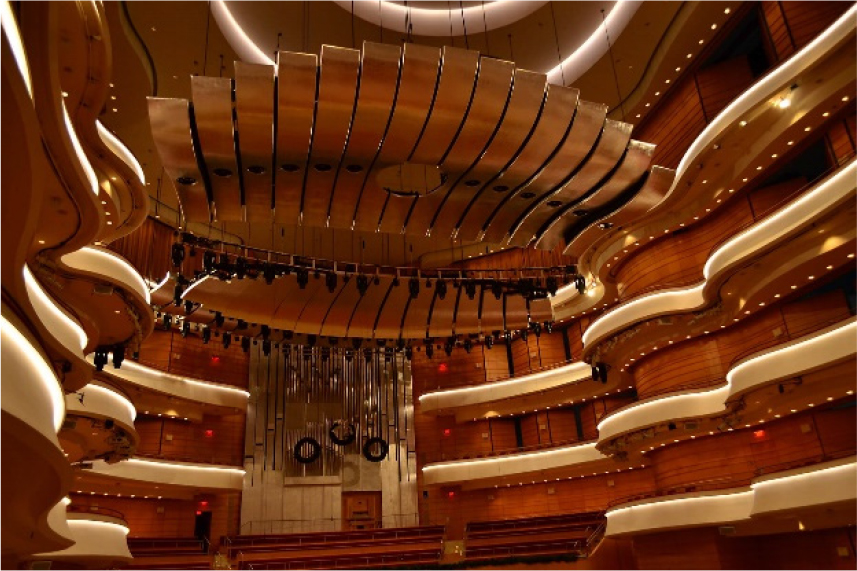
Fig. 24.
(Color available online) Adjustable acoustic canopy installed on the ceiling of Segerstrom Concert Hall.[57]
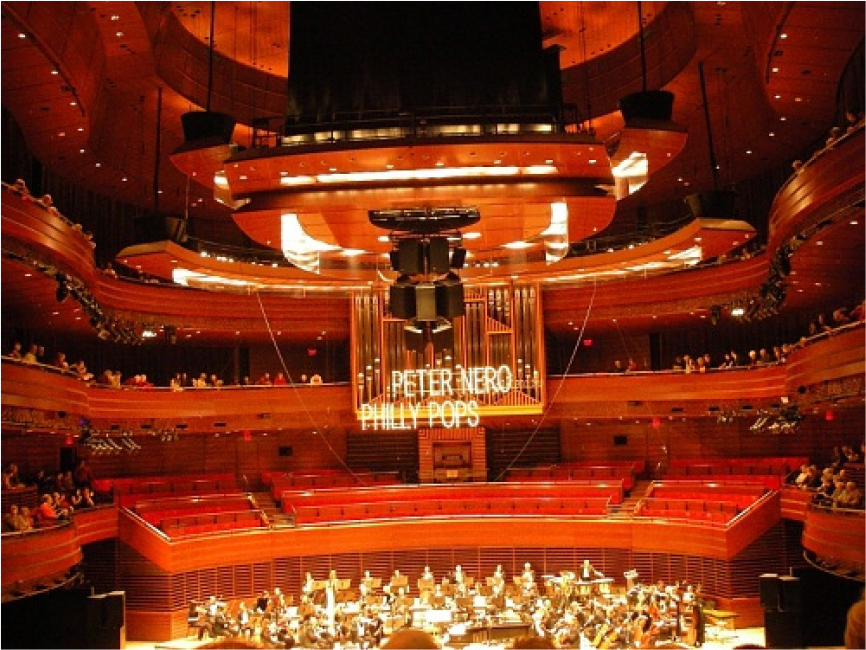
Fig. 25.
(Color available online) Adjustable acoustic canopy installed on the ceiling of Verizon Hall.[58]
In spite of its usefulness in controlling early energy, variable acoustics obtained by the use of acoustic canopy is limited and generally other adjusting systems, such as coupled volumes and variable absorption systems need to be incorporated for securing a wide range of variability. Also, continuous acoustic assessments and adjustments of canopy position are required for the successful onstage hearing and audience satisfaction.
III. Active control of room acoustics
With the development of the electronics industry in the 1960s, various types of artificial reverberators were developed. Since then, the digital artificial reverberators have been improved to a level similar to that of natural reverberation.
The concept and type of artificial reverberation are looked at and the types and concepts of the active acoustic system used in the concert hall are introduced in the present section. In addition, the active acoustic system applied to the concert hall are introduced by product.
3.1 The concept of artificial reverberation
The concept of an artificial reverberation device is a combination of several audio devices to mimic natural reverberation.
A phenomenon in which sound is propagated in indoor space, reflected and absorbed by walls or ceilings and objects, reducing sound energy is called natural reverberation. The feeling of reverberation is different depending on the size, shape, and finishing material of the indoor space.[59]
The spatial representation of reverberation is shown in Fig. 26 (a) and the time domain expression is shown in Fig. 26 (b).
An important concept for artificial reverberation is time delay and diminishing negative energy. In Fig. 26 (b), the time delay of direct and early reflective sounds is referred to as Initial Time Delay Gap (ITDG), which relates to the intimacy or presence of listeners and sounds. If ITDG is less than 25 ms, intimacy in the space is regarded as good.
The gradually reduced sound energy expresses the decrease in sound energy through reflections and sound absorptions, and is called reverberation.
Analogue’s typical artificial reverberation devices include echo chamber, plate reverse, spring reverse, and tape delay.[60] The sound energy was converted into mechanical vibration energy and applied to a medium (chamber, plate, or spring), and the energy transferred according to the medium was re-mixed with the original sound (direct sound) to create a sense of reverberation. Early artificial reverberation devices have limitations in reproducing a natural reverberation feeling because the time delay and reverberation density cannot be adjusted.[61]
3.1.1 Schroeder’s reverberator
The digital artificial reverberator started in 1961 with Schroeder’s Reverberator.[62,63,64,65] It is the first digital artificial reverberator consisted of five comb-filters and one all-pass filter. The five Comb-filters are reflective sound implementations in space, and the all-pass filter only changes the phase of the frequency, preventing changes in tone.
3.1.2 Moorer’s reverberator
In 1979, Moorer released a reverberator, an evolution of Schroeder’s reverberator.[66]
Fig. 27 shows as Moorer’s Reverberater is an algorithm that can control the initial delay time added to the concept of Schroeder’s Reverberater.
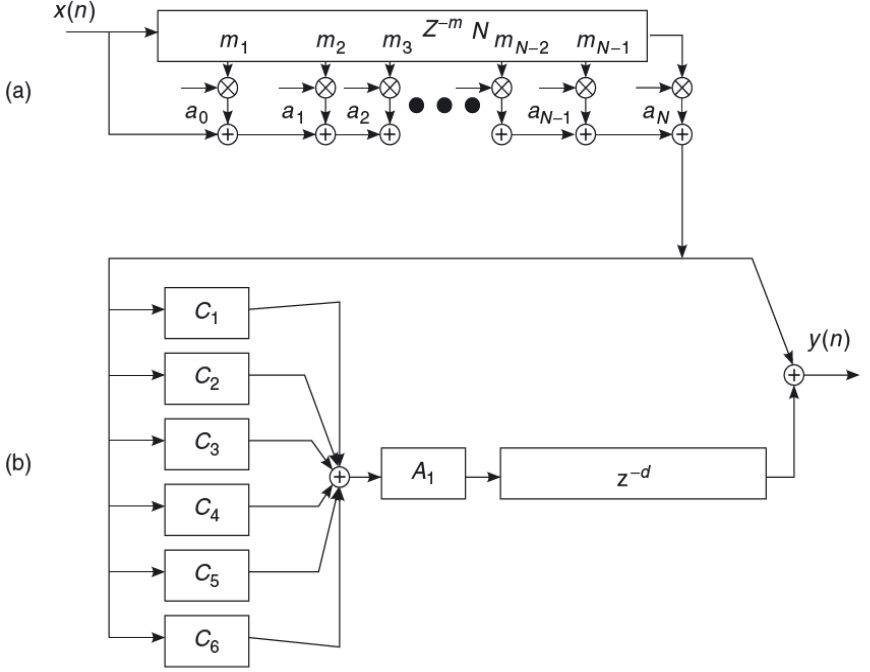
Fig. 27.
The block diagram of Moorer’s reverberator. (a) Tapped delay for early reflections part, (b) Schroeder’ reverberator part.[66]
The initial delay time gap is a parameter for recognizing the size of a space, and it is possible to create a reverberation feeling expressing a sense of empathy of various sizes.
In Fig. 27, (a) shows a tap dealy block diagram that adjusts the initial delay time of Moorer’s reverberater, Fig. 27 (b) is a block diagram of Schroeder’s reverberater. C represents comb-filter, A represents all-pass filter, and Z represents a time delay.
3.1.3 FDN reverberator
A more advanced reverberation device is the Feed-Back Delay Network (FDN), released in 1982 by J. Stautner and M. Puckette.[67]
The FDN consisted of mutual delay lines by linking feedback loops and matrices capable of generating more sophisticated ITDGs. Fig. 28 is a fourth-order block diagram of the FDN. FDN is a time-variant reverberator that has small feedback and tone variations in physically small spaces, and is capable of generating relatively large reverberations.[68]
3.1.4 Convolution reverb
The concept of Convolution Reverb was introduced in 1989.[69]Convolution Reverb implements reverberation by mathematically convoluting the Room Impulse Response (RIR) and input signal of a certain space with reverberation. Since the RIR is a function of the sound source and the receiving point in space, the reverberation at the location of the receiving point in the room can be obtained.
Convolution is expressed by the following equation.
Where x(m) is the input signal and h(n) is the RIR of space.
Convolution requires a lot of mathematical calculations and it is expensive to apply in real time. In order to solve this problem, the signal is calculated in units of blocks in the frequency domain through Fourier transform, and is again used after inverse Fourier transform.[70]
3.2 The type of active acoustic system
In Section 3.1, different types of artificial reverberation were investigated. Artificial reverberation had a great influence on the recording music industry such as tape, CD, and MP3. The use of artificial reverberation using microphones, Digital Signal Processors (DSPs), and speakers in performance hall is called the active acoustic system.[71,72]
The active acoustic system is divided into three types, in-line system and regenerative system, depending on the feed-back operation method. Recently, they are used in combination called hybrid system.[73]
3.2.1 In-line system
The in-line system is called a Non-Regenerative system, and it collects the direct sound using a directional microphone at a close distance (near field) from the sound source, processes the direct sound and reproduces it through speakers (Fig. 29).[73]
The advantage of the in-line system is that early reflection sounds can be adjusted, and the disadvantage is that it is difficult to adjust the overall reverberation time for a long time.
Representative systems to which the concept of in-line system is applied include Ambiophony, Early Reflected Energy System (ERES), Lexicon Acoustic Reverberation Enhancement System (LARES), and System for Improved Acoustic Performance (SIAP). Details about these systems are described in the case study section below.
3.2.2 Regenerative system
Regenerative system is called non-in-line system, and it collects reverberative sounds with an omni-directional microphones at a long distance (far field) from the sound source. It process the reverberative sound and reproduces through speakers (Fig. 30).[73]
The advantage of the regenerative system is that it is easy to control the reverberation time. Representative systems include Assisted Resonance System (AR), Multiple Channel Reverberation (MCR), CARMEN. Further details are dealt with in the case study section below.
3.2.3 Hybrid system
The Hybrid system combines the strength of the in-line system’s near-field microphone and the regenerative system’s far-field omni-directional microphone for signal processing (Fig. 31).[74,75,76]
Representative systems are VIVACE, Acoustic Field Controller (AFC) and Constellation.
3.3 Case studies
The development process of the Active Acoustic System is reviewed by organizing the systems applied to the multi-purpose hall .
3.3.1 Assisteed Resonance (AR) - 1964
AR was developed by Peter Parkin as an the Active Acoustics System with a regenerative concept.[77] Fig. 32 shows as a channel composed of mic, amp and loudspeaker is the basic unit, and AR plays only a single frequency. A Helmholtz resonator was installed in the Far field of Hall, and a specific single frequency was collected a microphone in it.[78,79,80]
The mid-frequency reverberation time of Royal Festival Hall (1964) was 1.4 s, shorter than the international standard of 1.8 s ~ 2.2 s. AR system was developed to improve the acoustic problems of the low frequencys.[81]
AR system used 172 channels in the Royal Festival Hall to lengthen the reverberation time within the frequency range of 58 Hz to 700 Hz, and typically increased from 1.4 s to 2.5 s at 125 Hz.[82]
In the other case, the reverberation time was adjusted in the frequency range from 72 Hz to 1,250 Hz by applying the 72 channel AR system in The Cental Hall, York, UK (1987). Typically, the reverberation time at 500 Hz increased from 0.8 s to 1.4 s.[83,84]
As AR system cannot increase the reverberation times at high frequencies, the increase in reverberation time is limited, and unwanted tone coloration occurs.[81,82].
3.3.2 Multi Channel Reverbration (MCR) - 1967
The MCR was developed in 1967 by Nico Franssen as a Regenerative concept. MRC is a channel consisting of a mic, equalizer, amplifier, and loudspeaker, which includes acoustic feedback control. Each channel has a wide frequency bandwidth compared to the AR system, and is independent and uncorrelated.[85,86,87]
As is shown in Fig. 33, as each channel amplify only the reflected sound without a time delay unit, increasing the energy density inside the hall results in raising the sound level.[88]
MCR System realizes smooth reverberation times through the equalization of all channels, and phase adjustment is not required.[89]Stavanger (1986) reported that the 40-channels MCR system installed in the Bjergsted Concert Hall could successfully increase the reverberation time by 50 % for the bass and 20 % for the treble.[88]
3.3.3 Early Reflected Energy System (ERES) - 1974
ERES is an in-line system developed by Christopher Jaffe in the early 1970s.[90]
Fig. 34 shows that ERES is a system consisting of several mics and three delay channels to improve initial reflexes when using an orchestra shell. The speakers for the first delay channel are installed at the top of the forestage to increase intimacy. The speakers for the second and third delay channels are installed at the top of the audience to play only the low frequencies to emphasize the warmth of the tone.
3.3.4 Lexicon Acoustic Reverberance Enhancement System (LARES)- 1988
LARES is an in-line system produced by Lexicon, known for its Revervb recording equipment.[91,92,93,94,95,96]The first LARES system was installed in 1991 to correct acoustic deficiencies at the Elgin Theater.
Two LARES systems were used to drive 116 speakers (the ceiling 56ea and the under balcony 60ea) through two microphone inputs where installed nearby balcony and 16 Lexicon reverberators installed (Fig. 35). Time variation, by using the reverberation algorithm, the feedback margin is improved by 8 dB compared to the non-time variation system.[91]
The time-varying reverberant is an algorithm that minimizes pitch shift to reduce timbre changes.[97]
3.3.5 System for Improved Acoustic Performance (SIAP) -1988
SIAP is an in-line system concept that was developed in 1988 in Netherlands for sound environments that balance visual and acoustic perception.[98,99,100,101] The basic hardware configuration of SIAP is to install 4 ~ 8 super-cadioid microphones near the stage, and play with 50 ~ 150 speakers on the ceiling and walls.[102]
Signal processing in SIAP utilizes an envelope that controls early reflections and late reverberation. The envelope is composed of attack, plateau and decay, and the user adjusts the size of each. Using a preset, a simple button operation can be changed into an optimal sound environment.[103]
3.3.6 Carmen -1998
As a regenerative system, Carmen developed an active virtual wall concept based on a cell with a microphone installed in front of the speaker (Fig. 36).[104,105,106,107,108]Usually, 20 ~ 30 independent cells are installed and operated in a hall.
The Carmen system of the Norwich Theater Royal with 27 cells can adjust the reverberation time from 1.1 s to 2.2 s, so it can be used not only for drama but also for classical symphony.[105]
3.3.7 VIVACE - 2008
VIVACE is an in-line System developed by Müller- BBM of Germany. A number of stage microphones and auditorium microphones are collected to create reflections and reverberations using a low-latency convolution algorithm. Fig. 37 shows that the speaker is installed on the wall and the ceiling, and the speaker installed on the wall uses a line array speaker that can adjust the direction. It is possible to control the sound of the audience by minimizing the loss of the sound pressure level according to the focusing and distance, which are characteristics of the line array.[109,110,111]
3.3.8 AFC Active Field Control (AFC) - 1987
The AFC system, which evolved into the Hybrid system, uses a time-invariant Finite Impulse Response (FIR) filter to control early reflection by installing a microphone in the stage area.[112,113,114]
In addition, “Electronic Microphone Rotator (EMR)” was used to create spatially averaged signals for the signals picked up by the four omni microphones installed on the upper part of the auditorium to ensure small timbre changes and system stability (Fig. 38).[115]
The AFC system installed in Arkas Sasebo Large Hall can change the reverberation time by 1.7 s ~ 2.3 s, and the system installed in SORA Hall in Kani Public Arts Center covers the range of 1.2 s ~ 1.8 s.[116]
3.3.9 Constellation - 2005
Constellation, a hybrid system, developed Variable Room Acoustics (VRA) system by Meyer Sound in the US.[117] The Constellation System shows the same effect as acoustically coupled rooms[118]
Fig. 39 shows as a reverberator is included between the microphone and speaker of each channel in a similar configuration to the 3.3.2 MCR.[89,119,120,121,122,123,124] It efficiently reverberates even small sounds while reducing the room’s background noise and timbre changes. The time-invariant type reverberator secures system safety by applying an all-pass filter to each channel.[125] This hybrid system aims to maintain reverberation properties in the audience area and early reflection properties in the stage area.
LOGOMO Hall, in Turku, Finland with Comstellation is a multi-purpose hall that can accommodate 1,100 seats, 1,700 seats and 3,500 seats using a movable seating stand (Tribune). The reverberation time of this hall can be increased from 0.9 s to 2.5 s with the Constellation system.[126,127]
IV. Concluding remarks
The conventional method of acoustic design is to develop the space for a balance of sound qualities for the primary performance. Sometimes, a limited amount of adjustability of acoustics allows a few of those qualities to be shifted from one listening setting to another. These adjustments help tune the space to match the performance and enhance the overall quality of the show, lecture, or performance.
However it is apparent that a space tuned to a specific performance cannot satisfy various different performance genres. In particular, Cultural & art centers in Korea which have been used for covering extremely wide range of cultural activities, it becomes inevitable to consider the use of variable acoustic systems for the satisfaction of both audience and performers.
Many types of passive and active variable acoustic systems have been developed and applied in performing arts spaces, with various ways of influencing the acoustical characteristics of the room. However not all of those systems are successful and it is partly due to poor understanding of characteristics of each control method. The intended range of variability needs to be clearly defined at the initial acoustic design stage for the successful implementation. As are reviewed in the previous sections, each system has its own pros and cons, hence a proper variable acoustic system should be chosen which suits it purpose. As the range of required variability increases, the more systems need to be incorporated.
There also exist criticisms[51,128] about the use of variable acoustics. Usually, a passive system changes the reverberation time by adjusting the amount of sound absorptive material or changing the volume of the space, while an active system electronically implements. However, it should be noted that adjustments of reverberation time are not sufficient to allow for excellent acoustics, especially in music performance venues. Great cares should be taken in these venues as the acoustic quality depended on not only reverberation times but many other important quantities such as the temporal and spatial history of early reflections including their amounts, lateral energies, and so on.
Overly complicated and unintuitive variable acoustic systems are difficult to handle by the technical staff and finally also rarely used properly. In some instances, it can also be observed that even simple, intuitive and efficient variable acoustic devices can be used wrongly. Acoustic consultants are responsible for the long-term monitoring of the rooms they have, and for educating and coaching the technical management staff. It is necessary to provide a final acoustic instruction manual for the users.
For the successful use of active system the initial room condition is very important as the system cannot be used to reduce reverberation. Even though the most widely used active acoustic system nowadays, the AFC and Constellation, can sufficiently simulate reverberation, a certain amount of natural reverberation is indispensable for securing naturalness of acoustics provided by active systems. The initial room condition before installing active system needs to be designed too dry is not recommended.




